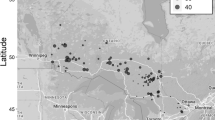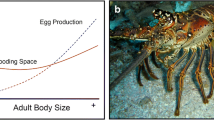Abstract
Positive static allometry is a scaling relationship where the relative size of traits covaries with adult body size. Traditionally, positive allometry is thought to result from either altered physiological requirements at larger body size or from strongly condition-dependent allocation under sexual selection. Yet, there are no theoretical reasons why positive allometry cannot evolve in fitness-related traits that are solely under the influence of natural selection. We investigated scaling and sexual dimorphism of a naturally selected trait, pectoral fin size, in comparison to a trait important in male–male combat, head width in natural populations of a fish, the desert goby Chlamydogobius eremius. Male desert gobies provide uniparental care and use their pectoral fins to fan the brood (often under hypoxic conditions); hence, larger fins are expected to be more efficient. Male pectoral fins do not appear to fulfil a signalling function in this species. We found that, for both pectoral fin size and head width, males exhibited positive allometric slopes and greater relative trait size (allometric elevation) than females. However, for head width, females also showed positive allometry, albeit to a lesser degree than males. Because fin locomotory function typically does not result in positive allometry, our findings indicate that other naturally selected uses, such as paternal care, can exaggerate trait scaling relationships.


Similar content being viewed by others
References
Andersson M (1986) Evolution of condition-dependent sex ornaments and mating preferences: sexual selection based on viability differences. Evolution 40:804–816
Bakker TCM, Mundwiler B (1999) Pectoral fin size in a fish species with paternal care: a condition-dependent sexual trait revealing infection status. Freshw Biol 41:543–551
Baldauf S, Bakker T, Herder F, Kullmann H, Thünken T (2010) Male mate choice scales female ornament allometry in a cichlid fish. BMC Evol Biol 10:301
Blake RW (1979) The mechanics of labriform locomotion I. Labriform locomotion in the angelfish (Pterophyllum eimekei): an analysis of the power stroke. J Exp Biol 82:255–271
Bonduriansky R (2007a) Sexual selection and allometry: a critical reappraisal of the evidence and ideas. Evolution 61:838–849
Bonduriansky R (2007b) The evolution of condition-dependent sexual dimorphism. Am Nat 169:9–19
Bonduriansky R, Day T (2003) The evolution of static allometry in sexually selected traits. Evolution 57:2450–2458
Bonduriansky R, Rowe L (2005) Sexual selection, genetic architecture, and the condition dependence of body shape in the sexually dimorphic fly Prochyliza xanthostoma (Piophilidae). Evolution 59:138–151
Cuervo JJ, Møller AP (2009) The allometric pattern of sexually size dimorphic feather ornaments and factors affecting allometry. J Evol Biol 22:1503–1515
Drucker E, Jensen J (1996) Pectoral fin locomotion in the striped surfperch. II. Scaling swimming kinematics and performance at a gait transition. J Exp Biol 199:2243–2252
Egset CK, Hansen TF, Le Rouzic A, Bolstad GH, Rosenqvist G, Pélabon C (2012) Artificial selection on allometry: change in elevation but not slope. J Evol Biol 25:938–948
Emlen DJ (1996) Artificial selection on horn length-body size allometry in the horned beetle Onthophagus acuminatus (Coleoptera: Scarabaeidae). Evolution 50(3):1219–1230
Engqvist L (2005) The mistreatment of covariate interaction terms in linear model analyses of behavioural and evolutionary ecology studies. Anim Behav 70:967–971
Farrell-Gray CC, Gotelli NJ (2005) Allometric exponents support a 3/4-power scaling law. Ecology 86:2083–2087
Ghiselin MT (1974) The economy of nature and the evolution of sex. University of California Press, Berkeley
Glover CJM (1982) Adaptations of fish in arid Australia. In: Barker WR, Greenslade PJM (eds) Evolution of the flora and fauna of arid Australia. Peacock, Adelaide, pp 241–246
Goldbogen JA, Potvin J, Shadwick RE (2010) Skull and buccal cavity allometry increase mass-specific engulfment capacity in fin whales. Proc R Soc Lond B 277:861–868
Green AJ (1992) Positive allometry is likely with mate choice, competitive display and other functions. Anim Behav 43:170–172
Green AJ (1999) Allometry of genitalia in insects and spiders: one size does not fit all. Evolution 53:1621–1624
Hankison SJ, Ptacek MB (2007) Within and between species variation in male mating behaviors in the Mexican sailfin mollies Poecilia velifera and P. petenensis. Ethology 113:802–812
Hansen TF, Bartoszek K (2012) Interpreting the evolutionary regression: the interplay between observational and biological errors in phylogenetic comparative studies. Syst Biol 61:413–425
Jones JC, Reynolds JD (1999) Costs of egg ventilation for male common gobies breeding in conditions of low dissolved oxygen. Anim Behav 57:181–188
Karlsson B, Wickman PO (1990) Increase in reproductive effort as explained by body size and resource allocation in the speckled wood butterfly, Pararge aegeria (L.). Funct Ecol 4:609–617
Klug H, Lindström K, Kokko H (2010) Who to include in measures of sexual selection is no trivial matter. Ecol Lett 13:1094–1102
Kodric-Brown A, Sibly RM, Brown JH (2006) The allometry of ornaments and weapons. P Natl Acad Sci USA 103:8733–8738
Kotiaho JS (2000) Testing the assumptions of conditional handicap theory: costs and condition dependence of a sexually selected trait. Behav Ecol Sociobiol 48:188–194
Künzler R, Bakker TCM (2000) Pectoral fins and paternal quality in sticklebacks. Proc R Soc Lond B 267:999–1004
Lindström K (1992) The effect of resource holding potential, nest size and information about resource quality on the outcome of intruder-owner conflicts in the sand goby. Behav Ecol Sociobiol 30:53–58
Lindström K, St. Mary C, Pampoulie C (2006) Sexual selection for male parental care in the sand goby, Pomatoschistus minutus. Behav Ecol Sociobiol 60:46–51
Maie T, Schoenfuss HL, Blob RW (2007) Ontogenetic scaling of body proportions in waterfall-climbing gobiid fishes from Hawai'i and Dominica: implications for locomotor function. Copeia 2007:755–764
Marshall LD (1990) Intraspecific variation in reproductive effort by female Parapediasia teterrella (Lepidoptera: Pyralidae) and its relation to body size. Can J Zool 68:44–48
R Development Core Team (2012) R: A language and environment for statistical computing. R Foundation for Statistical Computing, Vienna
Roff DA, Mousseau TA (1987) Quantitative genetics and fitness: lessons from Drosophila. Heredity 58:103–118
Rowe L, Houle D (1996) The lek paradox and the capture of genetic variance by condition dependent traits. Proc R Soc Lond B 263:1415–1421
Ruff CB (2000) Body size, body shape, and long bone strength in modern humans. J Hum Evol 38:269–290
Schluter D (1988) Estimating the form of natural selection on a quantitative trait. Evolution 42:849–861
Simmons LW, Tomkins JL (1996) Sexual selection and the allometry of earwig forceps. Evol Ecol 10:97–104
Smith RJ (1994) Degrees of freedom in interspecific allometry: an adjustment for the effects of phylogenetic constraint. Am J Phys Anthropol 93:95–107
Smith RJ (2009) Use and misuse of the reduced major axis for line-fitting. Am J Phys Anthropol 140:476–486
Svensson PA, Lehtonen TK, Wong BBM (2012) A high aggression strategy for smaller males. PLoS One 7:e43121
Sweeney BW, Vannote RL, Dodds PJ (1986) Effects of temperature and food quality on growth and development of a mayfly, Leptophlebia intermedia. Can J Fish Aquat Sci 43:12–18
Symons N, Svensson PA, Wong BBM (2011) Do male desert gobies compromise offspring care to attract additional mating opportunities? PLoS One 6:e20576
Tomkins JL, Radwan J, Kotiaho JS, Tregenza T (2004) Genic capture and resolving the lek paradox. Trends Ecol Evol 19:323–328
Vogel S (1994) Life in moving fluids: the physical biology of flow, 2nd edn. Princeton University Press, Princeton
Warton DI, Wright IJ, Falster DS, Westoby M (2006) Bivariate line-fitting methods for allometry. Biol Rev 81:259–291
Warton DI, Duursma RA, Falster DS, Taskinen S (2012) smatr 3—an R package for estimation and inference about allometric lines. Method Ecol Evol 3:257–259
Wickman P-O, Karlsson B (1989) Abdomen size, body size and the reproductive effort of insects. Oikos 56:209–214
Wong BBM, Svensson PA (2009) Strategic male signalling effort in a desert-dwelling fish. Behav Ecol Sociobiol 63:543–549
Acknowledgments
We thank Daniel Mosti for assistance with data collection, Joe Tomkins and David Warton for useful comments on the manuscript, and the Australian Research Council for funding.
Ethical standards
The experiments comply with the current laws of the country in which they were performed.
Author information
Authors and Affiliations
Corresponding author
Additional information
Communicated by J. Lindström
Rights and permissions
About this article
Cite this article
van Lieshout, E., Svensson, P.A. & Wong, B.B.M. Consequences of paternal care on pectoral fin allometry in a desert-dwelling fish. Behav Ecol Sociobiol 67, 513–518 (2013). https://doi.org/10.1007/s00265-012-1470-9
Received:
Revised:
Accepted:
Published:
Issue Date:
DOI: https://doi.org/10.1007/s00265-012-1470-9




